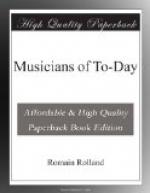But at least the Societe Nationale has gloriously achieved the task it set itself. In thirty years it has created in Paris a little centre of earnest composers of symphonies and chamber-music, and a cultured public that seems able to understand them.
* * * * *
2. The Grand Symphony Concerts
Although it was an urgent matter that young French composers should unite to withstand the general indifference of the public, it was more urgent still that that indifference should be attacked, and that music should be brought within reach of ordinary people. It was a matter of taking up and completing Pasdeloup’s work in a more artistic and more modern spirit.
A publisher of music, Georges Hartmann, feeling the forces that were drawing together in French art, gathered about him the greater part of the talented men of the young school—Franck, Bizet, Saint-Saens, Massenet, Delibes, Lalo, A. de Castillon, Th. Dubois, Guiraud, Godard, Paladilhe, and Joncieres—and undertook to produce their works in public. He rented the Odeon theatre, and got together an orchestra, the conductorship of which he entrusted to M. Edouard Colonne. And on 2 March, 1873, the Concert National was inaugurated in a musical matinee, where M. Saint-Saens played his Concerto in G minor and Mme. Viardot sang Schubert’s Roi des Aulnes. In the first year six ordinary concerts were given, and, besides that, two sacred concerts with choirs, at which Cesar Franck’s Redemption and Massenet’s Marie-Magdeleine were performed. In 1874 the Odeon was abandoned for the Chatelet. This venture attracted some attention, and the concerts were patronised by the public; but the financial results were not great.[216] Hartmann was discouraged and wished to give the whole thing up. But M. Edouard Colonne conceived the idea of turning his orchestra into a society, and of continuing the work under the name of Association Artistique. Among the artist-founders were MM. Bruneau, Benjamin Godard, and Paul Hillemacher. Its early days were full of struggle; but owing to the perseverance of the Association all obstacles were finally overcome. In 1903 a festival was held to celebrate its thirtieth anniversary. During these thirty years it had given more than eight hundred concerts, and had performed the works of about three hundred composers, of which half were French. The four composers most frequently heard at the Chatelet were Saint-Saens, Wagner, Beethoven, and Berlioz.[217]




